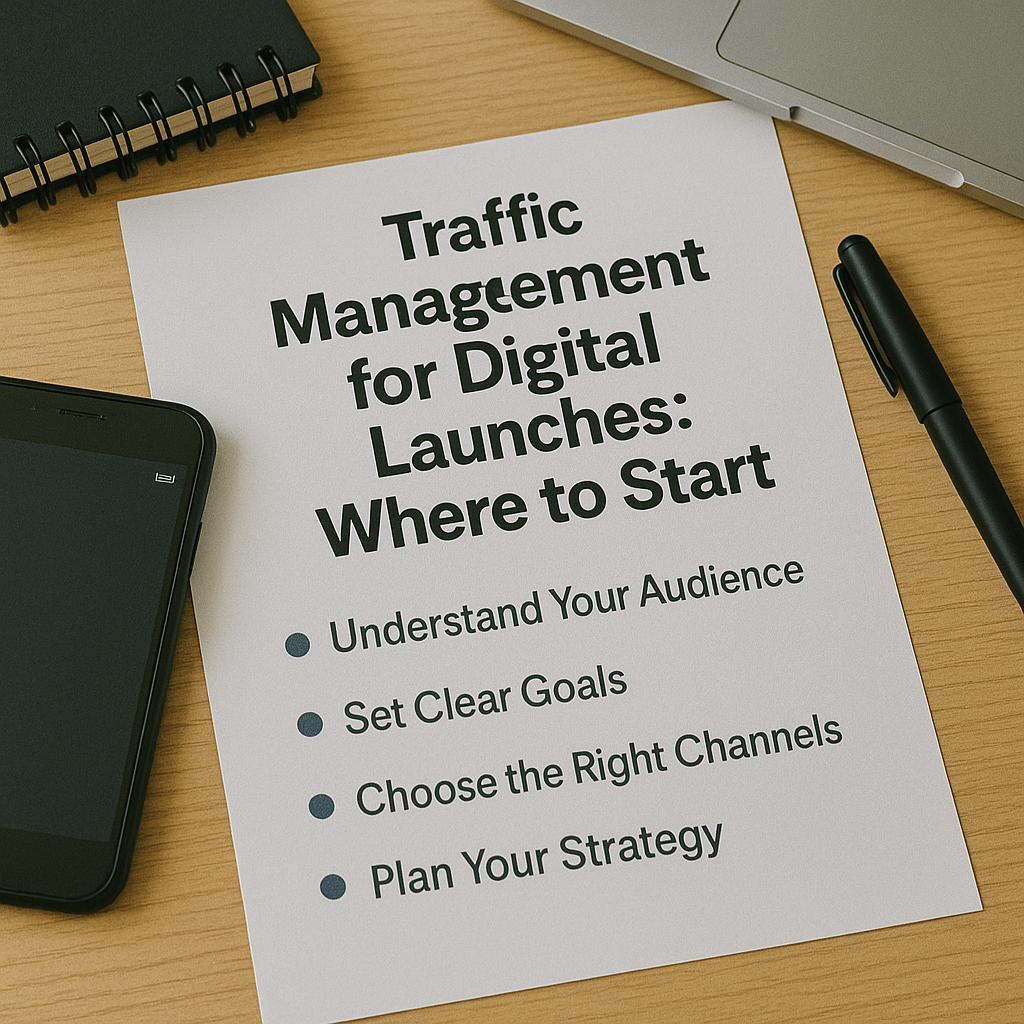Digital product launches—whether it’s an online course, eBook, membership, or coaching program—depend heavily on well-planned, high-performing ad campaigns. If you’re a traffic manager working on a launch (or want to be), your role is critical to its success.
In this guide, you’ll learn exactly how to approach traffic management for digital product launches, step-by-step—from pre-launch to post-launch.
Why Launches Are Different From Ongoing Campaigns
Most digital campaigns run continuously to generate leads or sales. A launch, on the other hand, is:
- Time-sensitive
- Budget-intensive
- Pressure-driven
- Focused on conversions in a short window
Your job as a traffic manager is not just to drive clicks, but to strategically warm up audiences, create urgency, and maximize conversions at the right moment.
The 3 Phases of a Digital Launch
1. Pre-Launch (Warming the Audience)
Goal: Build awareness, engagement, and anticipation.
During this stage, you’ll run top-of-funnel campaigns to attract cold audiences and begin nurturing them.
Tactics include:
- Video views campaigns on Facebook/Instagram
- Lead magnet campaigns (e.g., free eBook or webinar signup)
- Engagement ads to grow social proof
- Content promotion (articles, tips, testimonials)
You’ll also use this phase to build remarketing audiences (e.g., video viewers, page visitors, email subscribers).
2. Launch (The Core Offer)
Goal: Drive sales or signups during the official launch window (usually 3–10 days).
This is where the pressure rises. You’ll focus on retargeting warm audiences with direct-response ads.
Key actions:
- Create urgency-based ads: limited-time offers, bonuses, countdowns
- Retarget email list, website visitors, and content engagers
- Use testimonials, case studies, and success stories as ad creatives
- A/B test offers, pricing, and ad creatives quickly
Budgets usually spike during this phase—80% of the ad spend happens here.
3. Post-Launch (Waitlist or Downsell)
Goal: Capture missed opportunities and nurture future buyers.
After the cart closes, don’t stop. Run campaigns to:
- Promote a waitlist
- Offer a downsell (e.g., mini-course, consultation)
- Continue nurturing leads with valuable content
Smart traffic managers help clients maximize LTV (lifetime value) beyond the initial launch.
Ad Platforms to Use During a Launch
The most effective ad platforms for launches are:
Facebook & Instagram (Meta Ads)
- Excellent for cold-to-warm audience journeys
- Easy to scale fast
- Strong engagement tools (video views, IG stories, etc.)
Google Ads
- Useful for branded keyword protection (e.g., “Product Name + Reviews”)
- Display network for remarketing banners
- YouTube ads for testimonials or VSLs (Video Sales Letters)
TikTok Ads (Optional)
- Good for warm-up content and last-minute urgency
- Strong UGC-style creative performance
- Requires short, attention-grabbing videos
Most successful launch traffic managers combine Meta + Google for full-funnel coverage.
Key Campaign Structures for a Launch
Here’s a simplified breakdown:
Warm-Up Phase (Pre-Launch)
- Video Views: to build audiences
- Lead Generation: promote free resources or webinars
- Engagement: build social proof
Launch Phase (Open Cart)
- Website Conversions: focus on purchases
- Retargeting: show ads to anyone who engaged previously
- Lookalikes: scale with similar audiences to warm leads
Close Cart (Final 24–48 hours)
- Urgency Ads: countdowns, bonuses expiring
- Messenger/DM ads: drive last-minute questions and conversions
- High-frequency delivery to retargeted audiences
Post-Launch
- Waitlist signup ads
- Nurture email subscribers via low-budget retargeting
- Collect testimonials for next launch
Tracking and Optimization
You must track results in real time. Metrics to focus on:
- CTR (Click-Through Rate)
- CPL (Cost Per Lead)
- CPA (Cost Per Acquisition)
- ROAS (Return on Ad Spend)
- Lead-to-buyer conversion rate
- Funnel drop-off points
Use tools like:
- Meta Ads Manager
- Google Analytics 4
- Google Tag Manager
- UTM parameters for multi-channel clarity
Pro tip: Prepare daily reporting templates to monitor trends and react quickly.
Common Mistakes in Launch Traffic Management
- Waiting too late to start running ads
- Ignoring the warm-up phase
- Focusing only on cold traffic during launch
- Not retargeting properly
- Not adjusting ads mid-launch based on performance
- Relying on a single creative or audience
Launches move fast. A good traffic manager watches everything closely and makes bold, data-driven decisions quickly.
Collaborating With the Launch Team
You’ll often work with:
- Copywriters (email sequences, ad copy, landing pages)
- Designers or video editors (creatives)
- Funnel builders or developers
- Project managers
- The client directly (product owner)
Your role is central. Be proactive, communicate daily, and provide updates—even if you don’t have amazing results yet. Launches are team efforts.
Final Thoughts: Prepare, Execute, Optimize
Managing traffic for a digital product launch is one of the most exciting and high-pressure tasks in marketing. It tests your technical skills, strategic thinking, and adaptability.
To succeed:
- Start warm-up campaigns 2–3 weeks in advance
- Focus on building strong audiences
- Retarget hard during open cart
- Use urgency and storytelling
- Track performance obsessively
A traffic manager who delivers during a launch becomes indispensable to any digital business.

